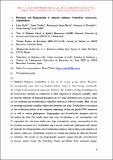Por favor, use este identificador para citar o enlazar a este item:
http://hdl.handle.net/10261/153773COMPARTIR / EXPORTAR:
 SHARE SHARE
 CORE
BASE CORE
BASE
|
|
| Visualizar otros formatos: MARC | Dublin Core | RDF | ORE | MODS | METS | DIDL | DATACITE | |

| Título: | Phylogeny and biogeography of Artemisia subgenus Seriphidium (Asteraceae: Anthemideae) |
Autor: | Malik, Sadia; Vitales, Daniel CSIC ORCID ; Qasim Hayat, Muhammad; Korobkov, Aleksandr A.; Garnatje, Teresa CSIC ORCID ; Vallès, Joan CSIC ORCID | Palabras clave: | Biogeography Compositae cpDNA Diversification Molecular phylogenetics nrDNA |
Fecha de publicación: | 1-ago-2017 | Editor: | International Association for Plant Taxonomy | Citación: | Taxon 66(4): 934–952 (2017) | Resumen: | Artemisia subg. Seriphidium is one of the largest groups within Artemisia, encompassing more than one hundred species, some of them having considerable ecological and economical importance. However, the evolution of subg. Seriphidium has received less attention in comparison to other subgenera of Artemisia, probably, apart from the difficulty of sampling throughout its very large distribution area, because of the low molecular and morphological variability observed in previous studies. Here, we use thorough taxonomic sampling within both Artemisia and subg. Seriphidium to reconstruct the evolutionary history of the subgenus, employing nuclear and plastid DNA sequences as well as various phylogenetic, biogeographic and diversification dynamics tools to analyse the data. Our results show that subg. Seriphidium is not monophyletic, but segregated into two main clades: one large monophyletic group corresponding to the formerly recognised sect. Seriphidium and a second, small clade, phylogenetically distant from the first. Biogeographic and diversification analyses indicate that a rapid radiation of species within sect. Seriphidium occurred in Central Asia during the Miocene-Pliocene transition. The results of our biogeographic analysis suggest that this diversification process started around the Tian-Shan, Pamir and Hindu Kush mountain ranges, subsequently expanding into the Eurasian continent. Finally, we uncovered numerous incongruences between taxonomic and genetic information in several sect. Seriphidium species, which could be explained by morphological uniformity, hybridisation and/or incomplete lineage sorting processes. | Descripción: | 19 p., tablas, figuras -- Contiene material suplementario -- Postprint del artículo publicado en Taxon. Versión revisada y corregida | Versión del editor: | https://doi.org/10.12705/664.8 | URI: | http://hdl.handle.net/10261/153773 | DOI: | 10.12705/664.8 | ISSN: | 0040-0262 | E-ISSN: | 1996-8175 |
| Aparece en las colecciones: | (IBB) Artículos |
Ficheros en este ítem:
| Fichero | Descripción | Tamaño | Formato | |
|---|---|---|---|---|
| Phylogeny_Vitales_2017.pdf | 1,46 MB | Adobe PDF |  Visualizar/Abrir | |
| PhylogenySupM_Vitales2017.pdf | Material suplementario 1 | 2,51 MB | Adobe PDF |  Visualizar/Abrir |
| nDNA_alignment.txt | Material suplementario 2 | 241,55 kB | Text | Visualizar/Abrir |
| cpDNA_alignment.txt | Material suplementario 3 | 276,12 kB | Text | Visualizar/Abrir |
CORE Recommender
SCOPUSTM
Citations
37
checked on 11-abr-2024
WEB OF SCIENCETM
Citations
34
checked on 25-feb-2024
Page view(s)
1.075
checked on 19-abr-2024
Download(s)
1.263
checked on 19-abr-2024
Google ScholarTM
Check
Altmetric
Altmetric
NOTA: Los ítems de Digital.CSIC están protegidos por copyright, con todos los derechos reservados, a menos que se indique lo contrario.
